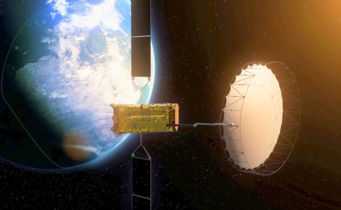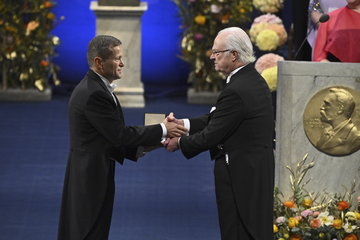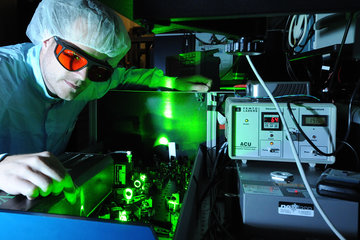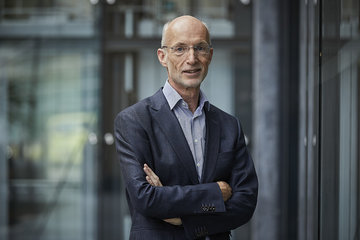Quantum communication with a satellite
In the future, it will be possible to use quantum cryptography in global communication by transmitting quantum information from orbit
What started out as exotic research in physics laboratories could soon change the global communication of sensitive data: quantum cryptography. Interest in this technique has grown rapidly over the last two years or so. The most recent work in this field, which a team headed by Christoph Marquardt and Gerd Leuchs at the Max Planck Institute for the Science of Light in Erlangen is now presenting, is set to heighten the interest of telecommunications companies, banks and governmental institutions even further. This is due to the fact that the physicists collaborating with the company Tesat-Spacecom and the German Aerospace Center have now created one precondition for using quantum cryptography to communicate over large distances as well without any risk of interception. They measured the quantum states of light signals which were transmitted from a geostationary communication satellite 38,000 kilometres away from Earth. The physicists are therefore confident that a global interception-proof communications network based on established satellite technology could be set up within only a few years.

Sensitive data from banks, state institutions or the health sector, for example, must not fall into unauthorized hands. Although modern encryption techniques are far advanced, they can be cracked in many cases if significant, commensurate efforts are expended. And conventional encryption methods would hardly represent a challenge for the quantum computers of the future. While scientists used to think that the realization of such a computer was still a very long way off, considerable progress in the recent past has now raised physicists’ hopes. “A quantum computer could then also crack the data being stored today,” as Christoph Marquardt, leader of a research group at the Max Planck Institute for the Science of Light, states. “And this is why we are harnessing quantum cryptography now in order to develop a secure data transfer method.”
Quantum mechanics protects a key against spies

In quantum cryptography, two parties exchange a secret key, which can be used to encrypt messages. Unlike established public key encryption methods, this method cannot be cracked as long as the key does not fall into the wrong hands. In order to prevent this from happening, the two parties send each other keys in the form of quantum states in laser pulses. The laws of quantum mechanics protect a key from spies here, because any eavesdropping attempt will inevitably leave traces in the signals, which sender and recipient will detect immediately. This is because reading quantum information equates to a measurement on the light pulse, which inevitably changes the quantum state of the light.
In the laboratory and over short distances quantum key distribution already works rather well via optical fibres that are used in optical telecommunications technology. Over large distances the weak and sensitive quantum signals need to be refreshed, which is difficult for reasons similar to those determining the fact that that laser pulses cannot be intercepted unnoticed. Christoph Marquardt and his colleagues are therefore relying on the transmission of quantum states via the atmosphere, between Earth and satellites to be precise, to set up a global communications network that is protected by quantum cryptography.
Measuring the light from Alphasat I-XL at the quantum level
In their current publication, the researchers showed that this can largely be based on existing technology. Using a measuring device on the Canarian island Teneriffe, they detected the quantum properties of laser pulses which the Alphasat I-XL communications satellite had transmitted to Earth. The satellite circles Earth on a geostationary orbit and therefore appears to stand still in the sky. The satellite, which was launched in 2013, carries laser communication equipment belonging to the European Space Agency ESA. The company Tesat-Spacecom, headquartered in Backnang near Stuttgart, developed the technology in collaboration with the German Aerospace Center as part of the European Copernicus project for Earth observation, which is funded by the German Federal Ministry for Economic Affairs and Energy.
While Alphasat I-XL was never intended for quantum communication, “we found out at some stage, however, that the data transmission of the satellite worked according to the same principle as that of our laboratory experiments,” explains Marquardt, “which is by modulating the amplitude and phase of the light waves.” The amplitude is a measure for the intensity of the light waves and the mutual shift of two waves can be determined with the aid of the phase.
The laser beam is 800 metres wide after travelling 38,000 kilometres
For conventional data transmission, the modulation of the amplitude, for example, is made particularly large. This makes it easier to read out in the receiver and guarantees a clear signal. Marquardt and his colleagues were striving to achieve the exact opposite, however: in order to get down to the quantum level with the laser pulses, they have to greatly reduce the amplitude.
The signal, which is therefore already extremely weak, is attenuated a great deal more as it is being transmitted to Earth. The largest loss occurs due to the widening of the laser beam. After 38,000 kilometres, it has a diameter of 800 metres at the ground, while the diameter of the mirror in the receiving station is a mere 27 centimetres. Further receiving mirrors, which uninvited listeners could use to eavesdrop on the communication, could easily be accommodated in a beam which is widened to such an extent. The quantum cryptography procedure, however, takes this into account. In a simple picture it exploits the fact that a photon – which is what the signals of quantum communication employ – can only be measured once completely: either with the measuring apparatus of the lawful recipient or the eavesdropping device of the spy. The exaction location of where a photon is registered within the beam diameter, however, is still left to chance.
The experiment carried out at the beginning of 2016 was successful despite the greatly attenuated signal, because the scientists found out that the properties of the signals received on the ground came very close to the limit of quantum noise. The noise of laser light is the term physicists use to describe variations in the detected photons. Some of this irregularity is caused by the inadequacies of the transmitting and receiving equipment or turbulences in the atmosphere, and can therefore be avoided in principle. Other variations result from the laws of quantum physics - more precisely the uncertainty principle - according to which amplitude and phase of the light cannot be specified simultaneously to any arbitrary level of accuracy.
Quantum cryptography can use established satellite technology
Since the transmission with the aid of the Tesat system already renders the quantum properties of the light pulses measurable, this technique can be used as the basis on which to develop satellite-based quantum cryptography. “We were particularly impressed by this because the satellite had not been designed for quantum communication,” as Marquardt explains.
Together with their colleagues from Tesat and other partners, the Erlangen physicists now want to develop a new satellite specifically customized for the needs of quantum cryptography. Since they can largely build on tested and tried technology, the development should take much less time than a completely new development. Their main task is to develop a board computer designed for quantum communication and to render the quantum mechanical random number generator space-proof, which supplies the cryptographic key.
Consequently, quantum cryptography, which started out as an exotic playground for physicists, became quite close to practical application. The race for the first operational secure system is in full swing. Countries such as Japan, Canada, the USA and China in particular are funneling a lot of money into this research. “The conditions for our research have changed completely,” explains Marquardt. “At the outset, we attempted to whet industry’s appetite for such a method, today they are coming to us without prompting and asking for practicable solutions.” These could become reality in the next five to ten years.











